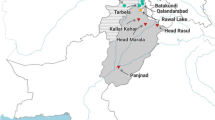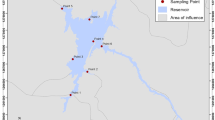Abstract
Mansour Eddahbi (MED) (30°55′N, 6°53′W) and Almassira (ALM) (31°95′N, 6°72′W) are two Moroccan lake reservoirs located at an arid and semi-arid hydrographic basin, respectively. Both are used for irrigation, recreational activities and drinking-water production. This paper deals with the characterization and quantification of microcystins (MC) from two Microcystis aeruginosa blooms occurring in those reservoirs. The toxicity of the blooms was confirmed and evaluated by both mouse and Artemia bioassays. The calculated LD50 values revealed that the MED bloom had a medium toxicity (LD50 = 358 mg kg − 1 body weight), whereas the ALM bloom had low toxicity (LD50 = 829 mg kg − 1 body weight). The 24-h LC50 values were 1.88 and 4.15 mg ml − 1 for the MED and ALM blooms, respectively, using Artemia assay. The identification and quantification of MC variants were carried out by high performance liquid chromatography (HPLC) equipped with a photodiode array detector, and HPLC coupled to mass spectrometry. The MC content, as Microcystin-LR (MC-LR) equivalents, was higher in the MED bloom (64.4 μg g − 1 dry weight) than in the ALM bloom (9.9 μg g − 1 dry weight). Five MC variants were identified in the MED cyanobacteria bloom (MC-RR, MC-YR, MC-LR, MC-FR, and MC-WR) and only one (MC-LR) in the ALM bloom. The results show that the occurrence of toxic cyanobacteria blooms in the studied reservoirs may be regarded as a health hazard; therefore, cyanotoxin monitoring in them is highly recommended.
Similar content being viewed by others
References
Abdel-Rahman, S., El-Ayouty, Y. M., & Kamael, H. A. (1993). Characterization of heptapeptide toxins extracted from Microcystis aeruginosa (Egyptian isolate). Comparison with some synthesized analogs. International Journal of Peptide and Protein Research, 41, 1–7.
Carmichael, W. W. (1996). Toxic Microcystis and the environment. In F. Watanabe, K. H. Harada, W. W. Carmichael, & H. Fujiki (Eds.), Toxic microcystis (pp. 1–11). Boca Raton: CRC.
Chorus, I., & Bartram, J. (1999). Toxic cyanobacteria in water. A guide to their public health consequences, monitoring and managements. WHO, London: E. & F. N. Spon, Routledge, 416 pp.
Codd, G. A., Metcalf, J. S., & Beattie, K. A. (1999). Retention of Microcystis aeruginosa and microcystin by salad lettuce (Lactica sativa) after spray irrigation with water containing cyanobacteria. Toxicon, 37, 1181–1185. doi:10.1016/S0041-0101(98)00244-X.
Codd, G. A., Morrison, L. F., & Metcalf, J. S. (2005). Cyanobacterial toxins: Risk management for health protection. Toxicology and Applied Pharmacology, 203, 264–272. doi:10.1016/j.taap.2004.02.016.
Cook, C. M., Vardaka, E., & Lanaras, T. (2004). Toxic cyanobacteria in Greek freshwaters, 1987–2000: Occurrence, toxicity, and impacts in the Mediterranean region. Acta Hydrochimica et Hydrobiologica, 32, 107–124. doi:10.1002/aheh.200300523.
De Figueiredo, D. R., Azeiteiro, U. M., Esteves, S. M., Goncalves, F. J. M., & Pereira, M. J. (2004). Microcystin-producing blooms—a serious global public health issue. Ecotoxicology and Environmental Safety, 59, 151–163. doi:10.1016/j.ecoenv.2004.04.006.
Douma, M., Loudiki, M., Sabour, B., Oudra, B., Mouhri, K., & Vasconcelos, V. (2005). Cyanobactéries des zones humides du Maroc: Inventaire & Distribution géographique. Acte des résumés du deuxième congrès Méditerranéen “Ressources en Eau dans le Bassin Méditerranéen” (WATMED 2), Marrakech, Maroc, p. 345
Hitzfeld, B. C., Hoger, S. J., & Dietrich, D. R. (2000). Cyanobacterial toxins: Removal during drinking water treatment, and human risk assessment. Environmental Health Perspectives, 108, 113–122. doi:10.2307/3454636.
Kiviranta, J., Sivonen, K., Niemela, S. I., & Huovinen, K. (1991). Detection of toxicity of cyanobacteria by Artemia salina bioassay. Environmental Toxicology and Water Quality, 6, 423–436. doi:10.1002/tox.2530060407.
Komarek, J., & Anagnostidis, K. (1999). Cyanoprokaryota. 1. Teil: Chroococcales. Süßwasserflora von Mitteleuropa; Band 19/1. Spectrum Akademischer verlag, Gustav Fischer, Berlin; 643 figures, 548 pp.
Komarek, J., & Anagnostidis, K. (2005). Cyanoprokaryota. 2. Teil: Oscillatoriales. Süßwasserflora von Mitteleuropa; Band 19/2. Spectrum Akademischer verlag, Elsevier GmbH, München; 110 figures, 759 pp.
Kurmayer, R., Dittman, E., Fastner, J., & Chorus, I. (2002). Diversity of microcystin genes within a population of the toxic cyanobacterium Microcystis spp. in lake Wannsee (Berlin, Germany). Microbial Ecology, 43, 107–118. doi:10.1007/s00248-001-0039-3.
Lawton, L. A., Beattie, K. A., Hawser, S. P., Campbell, D. L., & Codd, G. A. (1994). Evaluation of assay methods for the determination of cyanobacterial hepatotoxicity. In G. A. Codd, T. M. Jeffries, C. W. Keevil, & E. Potter (Eds.), Detection methods for cyanobacterial toxins (pp. 111–116). Cambridge: The Royal Society of Chemistry.
Loudiki, M., Oudra, B., Sabour, B., Sbiyyaa, B., & Vasconcelos, V. (2002). Taxonomy and geographic distribution of potential toxic cyanobacterial strains in Morocco. Annales de Limnologie, 38, 101–108.
Malki, M. (1994). Etude de la communauté phytoplanctonique et des caractéristiques physico-chimiques des eaux du lac reservoir Al Massira. Thèse de Doctorat d’état, Univ. Hassan II, Casablanca, 287 p.
Metcalf, J. S., Lindsay, J., Beattie, K. A., Birmingham, S., Saker, M. L., Torokne, A. K., et al. (2002). Toxicity of cylindrospermopsin to the brine shrimp Artemia salina: Comparisons with protein synthesis inhibitors and microcystins. Toxicon, 40, 1115–1120. doi:10.1016/S0041-0101(02)00105-8.
Mitrovic, S. M., Allis, O., Furey, A., & James, K. J. (2005). Bioaccumulation and harmful effects of microcystin-LR in the aquatic plants Lemna minor and Wolffia arrhiza and the filamentous alga Chladophora fracta. Ecotoxicology and Environmental Safety, 61, 345–352. doi:10.1016/j.ecoenv.2004.11.003.
Nasri, A. B., Bouaicha, N., & Fastner, J. (2004). First report of a microcystin containing bloom of the cyanobacteria Microcystis spp. in Lake Oubeira, eastern Algeria. Archives of Environmental Contamination and Toxicology, 46, 197–202.
Oudra, B., Loudiki, M., Sbiyyaa, B., Martins, R., Vasconcelos, V., & Namikoshi, M. (2001a). Isolation, characterization and quantification of microcystins (heptapeptides hepatotoxins) in Microcystis aeruginosa dominated bloom of Lalla Takerkoust lake-reservoir (Morocco). Toxicon, 39, 1375–1381. doi:10.1016/S0041-0101(01)00093-9.
Oudra, B., Loudiki, M., Sabour, B., Sbiyyaa, B., & Vasconcelos, V. (2001b). Étude des blooms toxiques à cyanobactéries dans trois lacs réservoirs du Maroc: Résultats préliminaires. Revue Des Sciences De l’eau, 15, 301–313.
Oudra, B., Loudiki, M., Sbiyyaa, B., Sabour, B., Martins, R., Amorim, A., et al. (2002). Detection and variation of microcystin contents of Microcystis blooms in eutrophic Lalla Takerkoust Lake, Morocco. Lakes and Reservoirs: Research and Management, 7, 35–44. doi:10.1046/j.1440-1770.2002.00165.x.
Padilla, C., Soledad, S.-A., & Del Campo, F. F. (2006). Toxin characterisation and identification of a Microcystis flos-aquae strain from a Spanish drinking-water reservoir. Archiv für Hydrobiologie, 165, 383–399. doi:10.1127/0003-9136/2006/0165-0383.
Paerl, H. W., Fulton, R. S., Moisander, P. H., & Dyble, J. (2001). Harmful freshwater algal blooms, with an emphasis on cyanobacteria. Science World Journal, 1, 76–113.
Pflugmacher, S., Jung, K., Lundvall, L., Neumann, S., & Peuthert, A. (2006). Effects of cyanobacterial toxins and cyanobacterial cell-free crude extract on the germination of alfafa (Medicago sativa) and induction of oxidation stress. Environmental Toxicology and Chemistry, 9(25), 2381–2387. doi:10.1897/05-615R.1.
Rohrlack, T., Henning, M., & Kohl, J. G. (2001). Isolation and characterization of colony-forming Microcystis aeruginosa strains. In I. Chorus (Ed.), Cyanotoxins—occurrence, effects, controlling factor (pp. 152–158). Heidelberg: Springer.
Saadani, M., Ouazzani, N., & Mandi, L. (2004). Impact de la sécheresse sur l’évolution de la qualité des eaux du lac Mansour Eddahbi (Ouarzazate, Maroc). Revue Des Sciences De l’eau, 17, 69–90.
Sabour, B., Loudiki, M., Oudra, B., Vasconcelos, V., Martins, R., Oubraim, S., et al. (2002). Toxicology of a Microcystis ichthyoblabe waterbloom from Lake Oued Mellah (Morocco). Environmental Toxicology, 17, 24–31. doi:10.1002/tox.10028.
Sabour, B., Loudiki, M., Oudra, B., Vasconcelos, V., Oubraim, S., & Fawzi, B. (2005). Dynamics and toxicity of Anabaena aphanizomenoides (Cyanobacteria) waterblooms in the shallow brackish Oued Mellah lake (Morocco). Aquatic Ecosystem Health & Management, 8, 95–104. doi:10.1080/14634980590914944.
Saqrane, S., El ghazali, I., Oudra, B., Bouarab, L., & Vasconcelos, V. (2008). Effects of cyanobacteria producing microcystins on seed germination and seedling growth of several agricultural plants. Journal of Environmental Science and Health. Part. B, Pesticides, Food Contaminants, and Agricultural Wastes, 43, 1–9. doi:10.1080/03601230802062307.
Sbiyaa, B., Oudra, B., Loudiki, M., Bouguerne, A., & Tifnouti, A. (1998). Acute toxicity of Microcystis aeruginosa KÜTZ. to three cladoceran species. In B. Reguera, J. Blonco, M. L. Fernandez, & T. Wyatt (Eds.), Harmful algae (pp. 29–31). Xunta de Galicia & Intergovernmental Oceanographic Commission of UNESCO.
Sivonen, K., & Jones, G. (1999). Cyanobacterial toxins. In I. Chorus, & J. Bartram (Eds.), Toxic cyanobacteria in water: A guide to their public health consequences, monitoring and management (pp. 41–111). London: E & Spon.
Vasconcelos, V. M. (2001). Toxic freshwater cyanobacteria and their toxins in Portugal. In I. Chorus (Ed.), Cyanotoxins—occurrence, effects, controlling factors (pp. 64–69). Heidelberg: Springer.
Vezie, C., Brient, L., Sivonen, K., Betru, G., Lefeuvre, J. C., & Salkinoja-Salonen, M. (1998a). Variation of microcystin content of cyanobacterial blooms and isolated strains in Lake Grand-Lieu (France). Microbial Ecology, 35, 126–135. doi:10.1007/s002489900067.
Vezie, C., Brient, L., Sivonen, K., Betru, G., Lefeuvre, J. C., & Salkinoja-Salonen, M. (1998b). Occurrence of microcystins containing cyanobacterial blooms in freshwaters of Brittany (France). Archiv für Hydrobiologie, 139, 401–413.
Vezie, C., Sivonen, K., Brient, L., Bertru, G., & Lefeuvre, J. C. (1996). Développement de cyanobactéries dans l’Ouest de la France. Détection de la toxicité par des tests sur Artemia salina. Annales de Limnologie, 32, 123–128.
Watanabe, M. F. (1996). Toxic Microcystis in eutrophic lakes. In M. F. Watanabe, K.-I. Harada, & W. W. Carmichael (Eds.), Toxic Microcystis (pp. 57–77). Boca Raton: CRC.
Wiegand, C., & Pflugmacher, S. (2005). Ecotoxicological effects of selected cyanobacterial secondary metabolites: A short review. Toxicology and Applied Pharmacology, 203, 201–218. doi:10.1016/j.taap.2004.11.002.
Author information
Authors and Affiliations
Corresponding author
Rights and permissions
About this article
Cite this article
Douma, M., Ouahid, Y., Campo, F.F.d. et al. Identification and quantification of cyanobacterial toxins (microcystins) in two Moroccan drinking-water reservoirs (Mansour Eddahbi, Almassira). Environ Monit Assess 160, 439–450 (2010). https://doi.org/10.1007/s10661-008-0708-5
Received:
Accepted:
Published:
Issue Date:
DOI: https://doi.org/10.1007/s10661-008-0708-5




